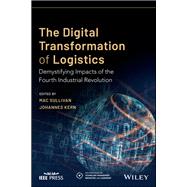The digital transformation is in full swing and fundamentally changes how we live, work, and communicate with each other. From retail to finance, many industries see an inflow of new technologies, disruption through innovative platform business models, and employees struggling to cope with the significant shifts occurring. This Fourth Industrial Revolution is predicted to also transform Logistics and Supply Chain Management, with delivery systems becoming automated, smart networks created everywhere, and data being collected and analyzed universally. The Digital Transformation of Logistics: Demystifying Impacts of the Fourth Industrial Revolution provides a holistic overview of this vital subject clouded by buzz, hype, and misinformation.
The book is divided into three themed-sections:
- Technologies such as self-driving cars or virtual reality are not only electrifying science fiction lovers anymore, but are also increasingly presented as cure-all remedies to supply chain challenges. In The Digital Transformation of Logistics: Demystifying Impacts of the Fourth Industrial Revolution, the authors peel back the layers of excitement that have grown around new technologies such as the Internet of Things (IoT), 3D printing, Robotic Process Automation (RPA), Blockchain or Cloud computing, and show use cases that give a glimpse about the fascinating future we can expect.
- Platforms that allow businesses to centrally acquire and manage their logistics services disrupt an industry that has been relationship-based for centuries. The authors discuss smart contracts, which are one of the most exciting applications of Blockchain, Software as a Service (SaaS) offerings for freight procurement, where numerous data sources can be integrated and decision-making processes automated, and marine terminal operating systems as an integral node for shipments. In The Digital Transformation of Logistics: Demystifying Impacts of the Fourth Industrial Revolution, insights are shared into the cold chain industry where companies respond to increasing quality demands, and how European governments are innovatively responding to challenges of cross-border eCommerce.
- People are a vital element of the digital transformation and must be on board to drive change. The Digital Transformation of Logistics: Demystifying Impacts of the Fourth Industrial Revolution explains how executives can create sustainable impact and how competencies can be managed in the digital age - especially for sales executives who require urgent upskilling to remain relevant. Best practices are shared for organizational culture change, drawing on studies among senior leaders from the US, Singapore, Thailand, and Australia, and for managing strategic alliances with logistics service providers to offset risks and create cross-functional, cross-company transparency.
The Digital Transformation of Logistics: Demystifying Impacts of the Fourth Industrial Revolution provides realistic insights, a ready-to-use knowledge base, and a working vocabulary about current activities and emerging trends of the Logistics industry. Intended readers are supply chain professionals working for manufacturing, trading, and freight forwarding companies as well as students and all interested parties.








